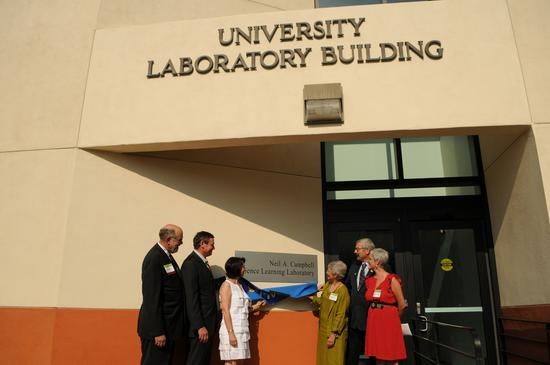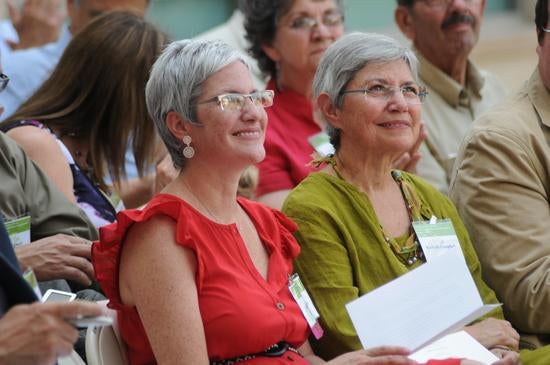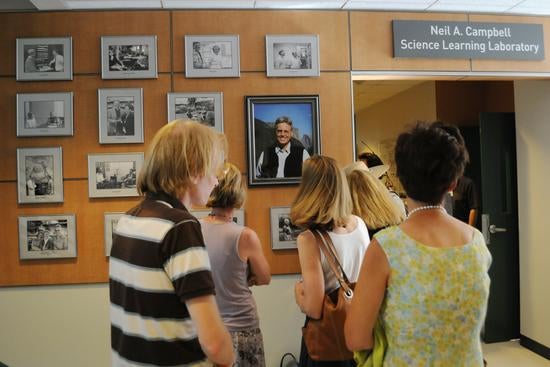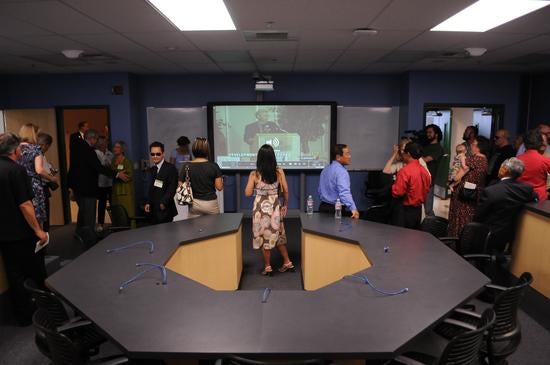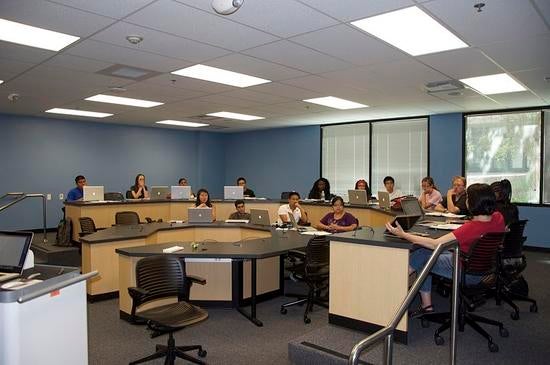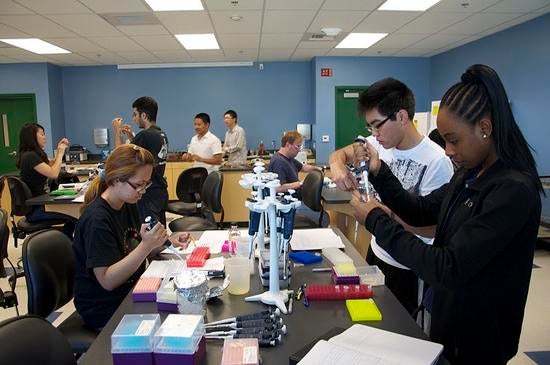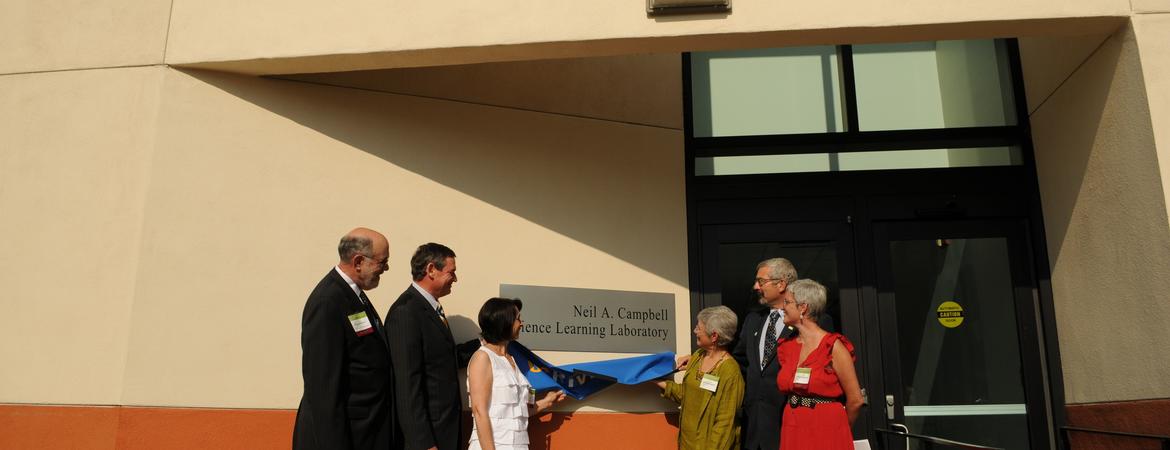
The grand opening of the Neil A. Campbell Science Learning Laboratory took place July 7. L to R: Thomas O. Baldwin, Timothy P. White, Susan R. Wessler, Rochelle Campbell, Rich Cardullo, and Allison Campbell. Photo credit: UCR Strategic Communications. (More photos below.)
RIVERSIDE, Calif. – An innovative laboratory for teaching science has opened at the University of California, Riverside that gives freshmen the kind of experimental research experience usually reserved for graduate students or undergraduate students in their junior or senior years.
Located in the University Laboratory Building, the “Neil A. Campbell Science Learning Laboratory” is named after a well-known biologist and UC Riverside alumnus. The grand opening took place yesterday.
Campbell, who died in 2004, was named in 2001 a “Distinguished Alumnus,” the highest award given by the UCR Alumni Association, for being an exceptional educator and supporter of science education. He is a co-author of Biology, an introductory text widely used in both high school and college-level classes.
The Campbell Learning Lab was made possible by a generous gift of about $520,000 by Rochelle Campbell, wife of the late Neil Campbell. Funds from the gift were used to renovate the first floor of the University Laboratory Building.
The lab is home to “The Dynamic Genome,” a laboratory-intensive learning program launched by Susan Wessler, who holds a University of California President’s Chair and is a distinguished professor of genetics in the Department of Botany and Plant Sciences at UCR. A portion of a $1 million Howard Hughes Medical Institute grant to Wessler is being used to fund the learning program.
“Like Neil, Rochelle has a passion for science education and the promotion of science literacy, and she cares deeply about Dr. Sue Wessler’s work in bringing new teaching technologies and techniques to our undergraduate classrooms,” said Chancellor Timothy P. White. “UCR greatly appreciates her generous gift to help renovate the lab, which we name in honor of her husband.”
Research opportunity for students
The Campbell Learning Lab includes a lecture hall, teaching lab, and office space. The first course at the lab will begin this fall quarter. Students in the program will learn computational and experimental tools of genome analysis to understand how evolution works.
Farhad Ghamsari, a sophomore this fall at UCR, attended a five-day workshop held last month at the Campbell Learning Lab.
“What clearly distinguished this lab for me was that it pushed me to think freely and independently,” said Ghamsari, who is majoring in biology. “It focused on problem solving, with all our efforts being steered toward achieving a result. A lot of cognitive thinking was involved, for sure. In a nutshell, what I got from participating in the workshop was a hands-on experience that also welcomed – and encouraged – my own thinking and input.”
The Dynamic Genome project replicates Wessler’s research program as an undergraduate classroom laboratory where students are often the first to analyze transposable elements. These elements, which are DNA pieces that can move from one genomic location to another and that contribute the raw material used by plants and animals to adapt to an ever changing environment, play a key role in evolution and are ideal for study in an undergraduate course because they are fairly simple biological systems that provide a manageable amount of information.
“Our students will get to analyze portions of a genome and learn that it is not just an instruction manual, but a historical record of how organisms evolve,” said Wessler, a passionate advocate for spreading the excitement of genomic science as widely as possible. “There is no better way to refute the idea of ‘intelligent design’ than to show what a mess the genome is!”
Wessler believes that at research universities teaching often takes a back seat.
“As a result, undergraduates can get ‘turned off’ in introductory science courses and never sign up for another one,” she said. “For students to understand and become energized about science, they need to first participate in the discovery process. Laboratories like the Campbell Learning Lab teach freshmen how to design and conduct experiments, analyze data, and write about the results. Such an early exposure to experimental science can only encourage more bright minds to choose science careers.”
Wessler is being assisted in running the Campbell Learning Lab by Jim Burnette, Ph.D., an academic coordinator and professional researcher. Graduate students and postdoctoral researchers are assisting Wessler in teaching the courses.
The total cost of renovating the space for the Campbell Learning Lab is about $700,000; state funds were used for the portion of the overall cost not covered by the gift from Rochelle Campbell.
“The Campbell Learning Lab is going to transform the way students learn the principles of science just as surely as Neil Campbell’s textbook transformed the way students learn biology,” said Thomas O. Baldwin, the dean of the College of Natural and Agricultural Sciences. “What Sue Wessler will be doing here, what Rochelle Campbell and Neil Campbell have made possible, is nothing less than a revolution in how we teach scientists.”
Grand opening, July 7
The naming ceremony featured White, Wessler, and Baldwin as speakers.
John C. Kay, a biology teacher based in Hawai`i; Sharman D. O’Neill, a professor of biological sciences at UC Davis; Allison Campbell, daughter of Neil and Rochelle Campbell; and Beth Wilbur, the vice president and editor-in-chief of Biology and Environmental Science, Pearson Education, paid tributes to Neil Campbell.
Allison Campbell marveled at the number of people who attended the grand opening ceremony and who also knew her father.
“This is a wonderful day for my family,” she said. “My father was fiercely curious by nature. He would rack his brain to understand things big and small. His greatest impact, I believe, was in science education.”
Richard Cardullo, a professor of biology and the divisional dean of life sciences at UCR’s College of Natural and Agricultural Sciences, presided over the official naming of the lab.
“Neil was a true scholar who understood that science is a creative endeavor,” Cardullo said. “He loved learning and was always in pursuit of knowledge. He would have loved this new facility, which shows the true nature of science to young students in an active learning environment.
About Neil A. Campbell
Neil Allison Campbell earned his doctorate in biology at UCR in 1975. He taught at Pomona College, Cornell University, and San Bernardino Valley College, returning to UCR in 1989 as a visiting scholar in the Department of Botany and Plant Sciences.
A specialist in biology education, he helped develop and evaluate new instructional media while continuing his research in desert and coastal plants.
His untimely death in 2004 came just after completing the manuscript for the seventh international edition of Biology, co-authored with Jane Reece. At the time, Pearson-Benjamin Cummings, the publisher, estimated that 67 percent of all US biological scientists, physicians, biology teachers, and biotechnologists under the age of 37 had used Biology as their introductory text.
Campbell is the author also of three other textbooks for non-biology majors. He developed “Biology: Exploring Life” as a program for high school students. His textbooks have been translated into seventeen languages and used by more than six million students worldwide.
